|
What
Midwest Soldiers Found in Nazi Concentration Camps
Strangely, just as Iowans, Minnesotans and Dakotans were
the first U.S. troops to fight in Europe in World War II, a large number
of Upper Midwesterners also were at hand at the war's end, as the U.S.
Army liberated Buchenwald, Dachau and other Nazi concentration camps in
April and May of 1945. Some of the men photographed what they saw; others
glimpsed images on those first days of liberation that would remain indelibly
burned in their minds for the rest of their lives.
Vernon Tott | Jack Kriegel | Eugene Rinkey photos and his story | other photographers
|
|
Vernon Tott
Sioux City, Iowa
Before the war a meat-packer in Sioux City, Iowa, 20-year old Vernon
Tott served as a radio operator in the U.S. Army’s 335th Infantry
Regiment, the 84th “Railsplitters” Division. On 10 April
1945 he was among the first to spy and enter a slave-labor camp
in Hannover-Ahlem. A desperate place, the camp’s inmates consisted
largely of men and boys transported from the liquidated Lodz ghetto
in Poland and put to work digging bomb-proof tunnels and industrial
facilities. What the young Iowan discovered and filmed inside the
camp gates haunted him for over five decades—until, by chance,
he ran across an appeal
by one of the camp survivors to locate his liberators… In
2005 former inmates visited
him in his Iowa home. Today, Vernon Tott’s name hangs in honor
in the United States Holocaust Memorial
Museum—and his photos
bear witness. In Vernon’s own words, he has described what
he saw and how it later affected him.
To explore the implications of the Holocaust for today's world, as
well as how to use history as a means to address contemporary
issues, click on Facing
History and Ourselves. |
Jack Kriegel
Tama-Toledo, Iowa
In the summer of 2004, TRACES’ BUS-eum
visited the Tama-Toledo Pow-Wow Days, in East Central Iowa. During
the course of the busy, loud happenings of the festival, a quiet
man approached Michael Luick-Thrams and shyly produced an old envelope
full of tattered photos… This ritual repeated itself in town after town
as the exhibit Behind Barbed Wire: Midwest POWs in Nazi Germany
exhibit toured Iowa and later Nebraska in 2004. It seems that hundreds—likely
thousands—of Midwest soldiers were present at the liberation
of Buchenwald, Dachau and many other Nazi concentration camps. Time
after time, the men described how the horrific scenes they saw in
those camps tormented them for half a century—yet only now,
late in their lives, are a few able to speak about them. Jack Kriegel
is one of them... It seems that the very act of “telling the
secret” heals decades-old emotional wounds—pain that
no human being should have to carry. |
|
Eugene Rinkey of Saint Paul, Minnesota
The below color photographs were taken by
Eugene Rinkey of Saint Paul. Rinkey became a medical doctor upon
his return from the war in Europe. In 1987 he wrote about what he
had seen and experienced at Dachau:
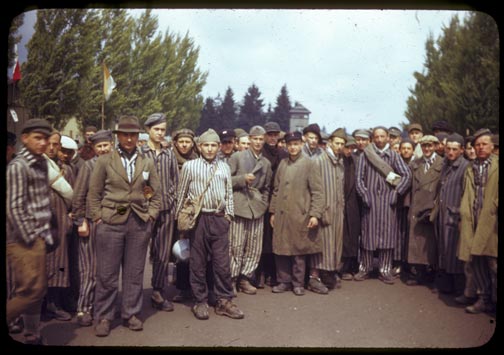 |
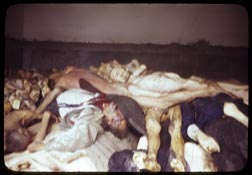 |
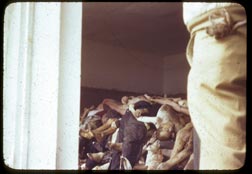 |
It was Tuesday, May 1st 1945, in western Germany. I arrived by
Jeep along with Charlie and "Chappie" (our chaplain) to
a new bivouac in some of the most beautiful countryside I had ever
seen. It was a pastoral scene that brought with it a relaxing
sense of peace…
The next day,
Wednesday, May 2nd, [other soldiers] and I rode down to Dachau,
about 15 miles north of Munich. We had been hearing on our radios
horror stories of the Nazi death camps. When we parked our vehicle
about 200 feet from the entrance, all appeared peaceful. The
fences were high and topped by barbed wire. There were masses of
people milling about inside the fence, but still there was an air
of quiet. The grounds were neat outside the fence and the sky was
a beautiful blue with just a few clouds. As we walked closer, the
pastoral beauty was marred by two jarring sights.
Before us, lying
in the ditch, was the battered body of a Nazi S.S. soldier, who
had been snatched away from the U.S. troops who were protecting
him from the prisoners, and was beaten to death with clubs, rocks,
fists! Even though he was lying there nude, one could tell he was
not a prisoner, since he was the only one around who had any fat
on his body.
On our left was a
railroad siding with a boxcar providing a most gruesome sight. The
door was open and countless nude bodies could be seen in the car,
some hanging half out of the door, while numerous others were
lying on the ground. There [also] were many little children. They,
as well as the adults, had all the earmarks of longstanding
malnutrition. The expression "skin and bones" applied
perfectly.
Entering the
camps we saw thousands of persons, nearly all male, mostly dressed
in prison garb with black and white vertical stripes. Most of them
appeared to be anemic, showing the profound weight loss associated
with starvation. Within moments of entering the gates the crowd of
prisoners surrounded us. They caressed our woolen short coats as
though to garner some strength or sustenance from the contact.
As we attempted
to move along, one bedraggled fellow looked at me questioningly
and asked, "Bist der un yid?" "Are you a Jew?"
When I nodded "yes" he was so overjoyed it was
impossible to describe. It was as though a spark had ignited a
flash fire. In moments I was surrounded by fifty Jews all talking
at once and "shushing" each other. They stated that
there were 2,000 Jews in the camp and expressed fears they would
not be treated equally. I tried my best to reassure them that
everyone would be treated well and equally by the American troops.
The subservient
attitude, the deference shown us was both pathetic and
embarrassing. As we walked by men doffed their hats, bowed or
saluted. Others shouted, "Macht Platz!" ("Make
way!") as we walked along. A Polish priest born in
Connecticut acted as our guide. He had left for Poland in1932.
Then in 1942 he became a prisoner in this camp. Can I ever forget
his exuberant "My Gosh, we were happy when the Americans came
on Sunday." To hear that Americanism contrasted with his
broken English was heartwarming.
He went on to
inform us that the census was 32,000, mostly political prisoners
[as well as] some soldiers. Included were Poles, Dutch, Russians,
Yugoslavs, Czechs, French and Jews. "Two to three hundred die
daily of malnutrition and disease" he said. "There was a
flare-up of typhus in January and February. In addition there is
much TBC [Tuberculosis]!" Of the original 30,000 prisoners in
1939, there remained only six persons.
The priest went
on to say that 5 million Jews were killed in Poland, that none
remain. We couldn't comprehend such numbers. He continued:
"Of 2,200 priests of all nationalities, few are alive. All
priests but Poles are permitted to use the chapel at Dachau. If a
man is found with a rosary, he is forced to kneel in the street
and others must spit on him as they pass by."
In Block 24 we
saw fresh inmates from Buchenwald, who differed from the corpses
only in the fact that they still moved, groaned and breathed. A
little one lay on the floor on a narrow passageway, recently
expired. Eight men sleep in a space designed for three. The space
from the bottom of a bunk to the top still reminds me of a bakery
with barely enough space for each loaf.
Gangrenous hands
and feet bedsores and wounds were all untreated. A horrible sight
never to be forgotten! They were used as human guinea pigs. They
were inoculated with various diseases and experimental drugs were
used. There was a separate compound with 300 Jewesses. There were
eleven whores living with the men. The S.S. officers took pleasure
in watching them cohabit. The whores were promised freedom but
were shot before the S.S.
On our left as we
entered, there was a one story brick building. As we faced it,
there were two tall chimneys with dark gray smoke drifting upward.
In front of this building was a pit about 25 feet square, 15 feet
deep and surrounded by a strong wire fence about 10 feet high. On
the wall of the pit, adjacent to the brick building were several
small doors. Imbedded in this wall about 8 feet high were several
meat hooks such as are seen in packing plants. We were told that
in another camp, live prisoners were thrust on the hooks and
starving dogs were set loose to devour as much of the prisoners as
they could reach!
Next we walked
around the pit described above and entered the "shower"
room. It appeared to measure about 30 feet square. It was neatly
tiled and the ceiling was low with about 10 or 20
"shower" heads. The floor had a number of drains
scattered about. The only oddity was the two doors, made of steel
and diagonally opposite each other, constructed to make an
airtight closure. The victims were headed into the room,
instructed to remove all their clothing, then they were given a
piece of soap and a towel. The doors were then closed and the gas
was turned on. An observation window allowed the Nazis to watch
the death struggles (in the interest of science, perhaps?).
Our tour next
took us to the other side of the building, below the smokestacks.
Before us were four giant ovens, one of which had a brisk fire
burning. On either side of the ovens were stove rooms containing,
on the left, dozens of nude bodies and, on the right, bodies
partially clothed (another example of Nazi efficiency?). Again,
one saw extreme emaciation and countless sores. The eyes! Those
that were open seemed to reflect accusation, an indictment of a
world that could overlook such cruelty.
It is estimated
that at least 100,000 persons had been murdered in this camp.
The priest quoted
a recent message from Himmler ordering evacuation of the camp on
Monday, April 30th, 1945, with instructions to murder all the
prisoners before leaving. The S.S. were busily engaged in
following orders by machine gunning the prisoners when the
Americans arrived. They showed me a penciled memo purportedly from
Himmler that confirmed the priest's statement.
With some
difficulty I tore myself away after giving them a package of
cigarettes and taking some pictures. Before leaving, we visited
the surgery where there were three well-equipped operating rooms.
There were three surgeons-one Pole, one Slav, one Czech and five
assistants. The Polish doctor, Myer, told of spending 12 hours in
surgery daily.
Thus ended
"A Day in the Country." Although this was 42 years ago,
the scenes I have attempted to describe, albeit inadequately,
remain burned indelibly in my memory.
|
images by other photographers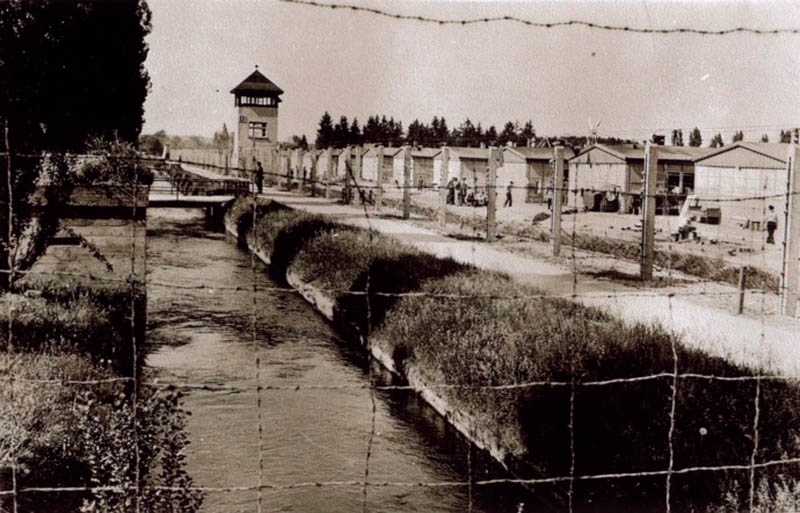 |
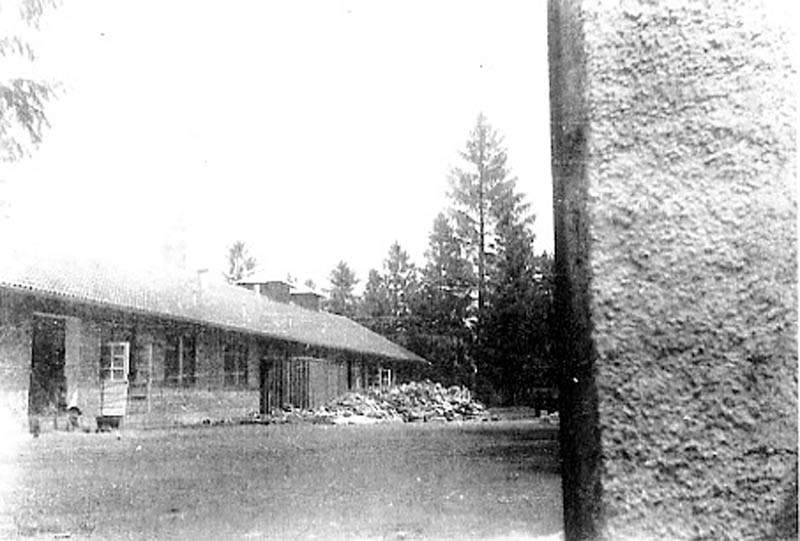 |
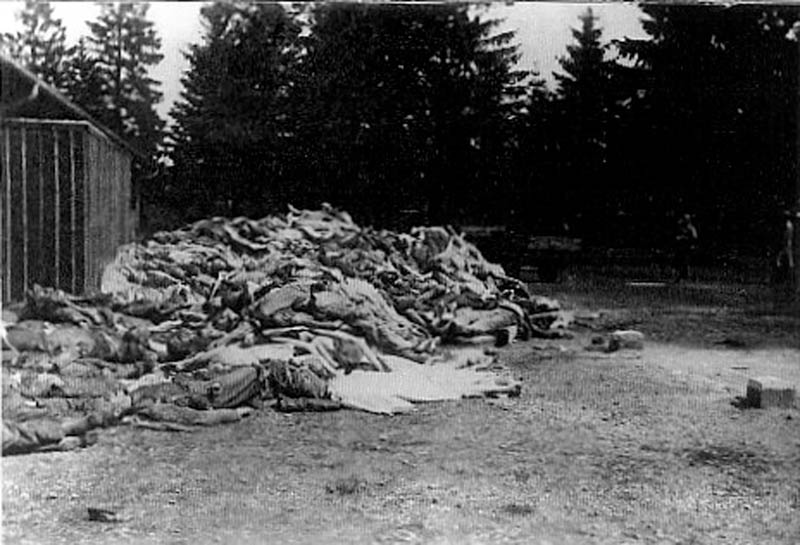 |
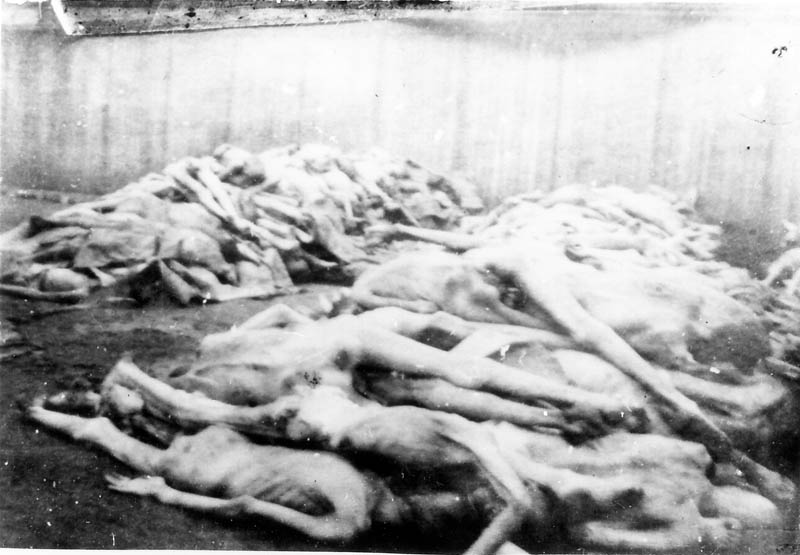 |
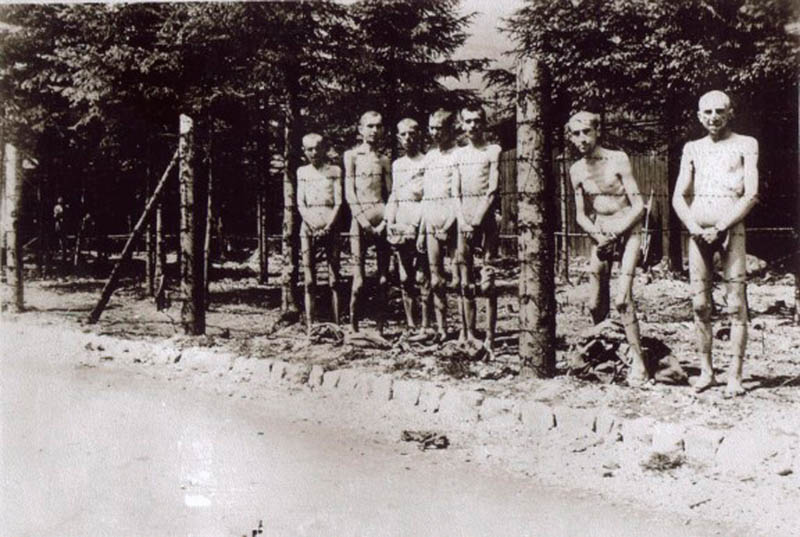 |
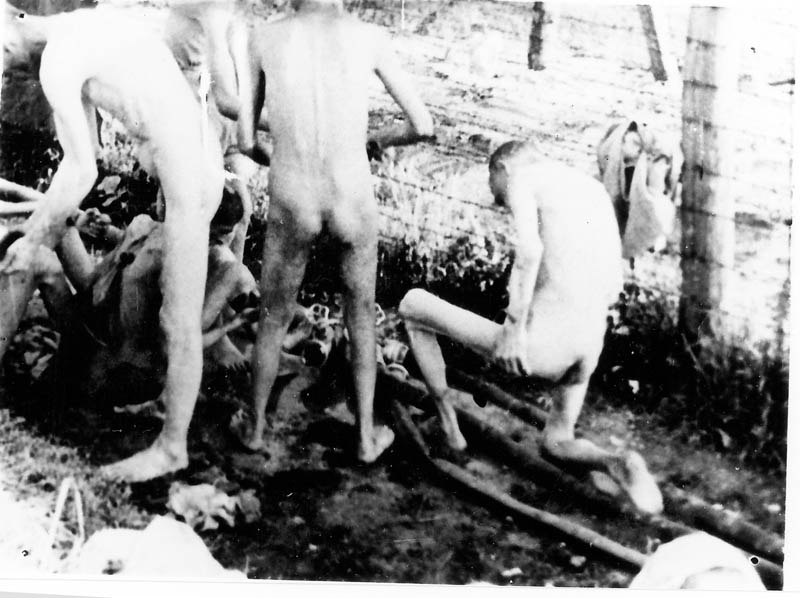 |
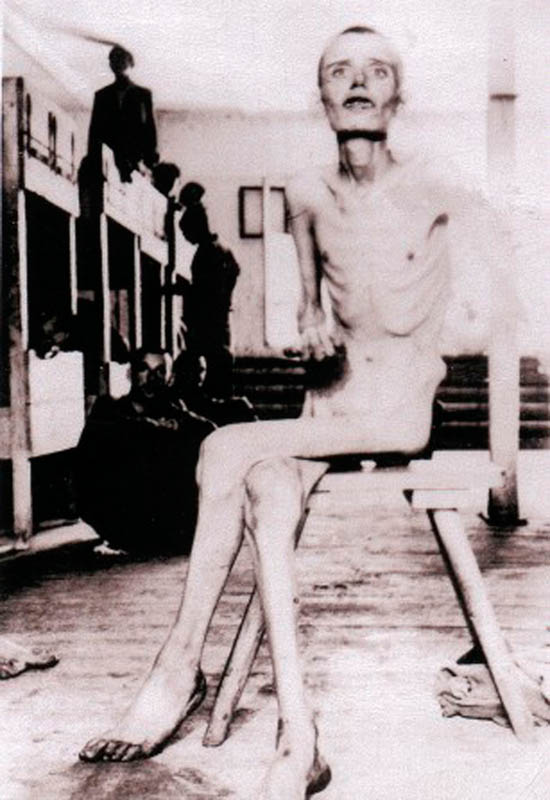 |
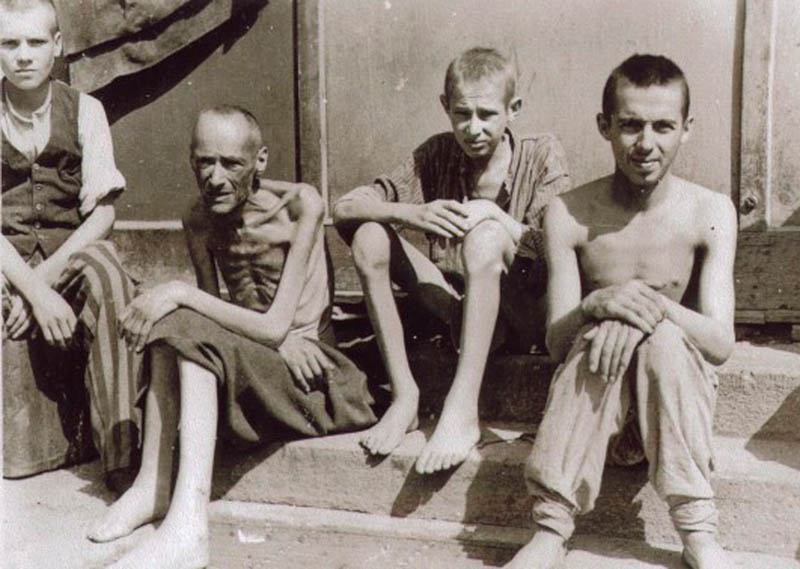 |
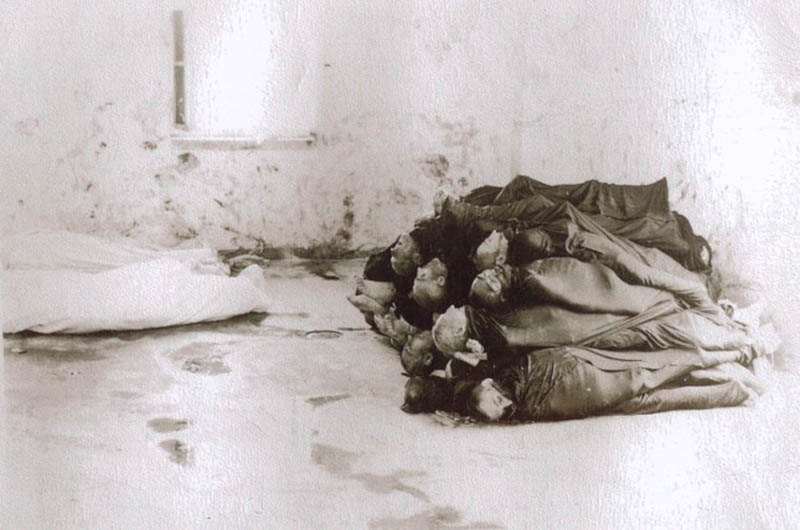 |
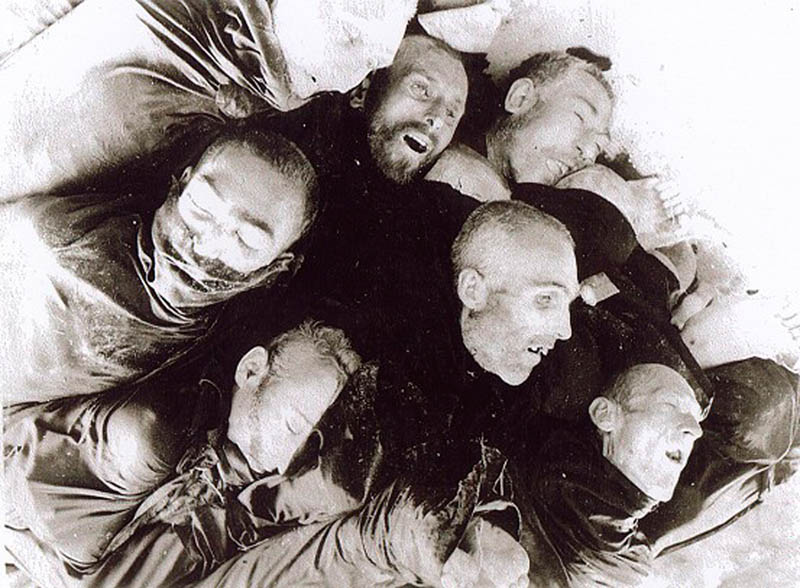 |
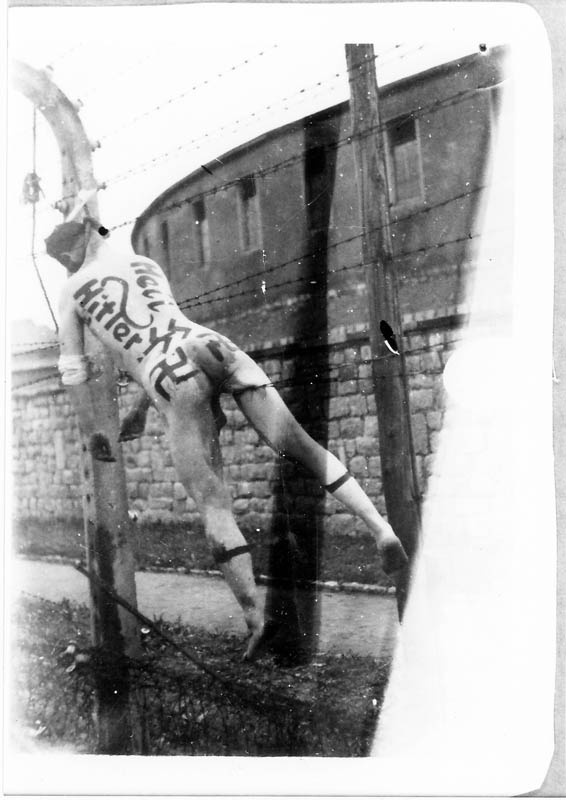 |
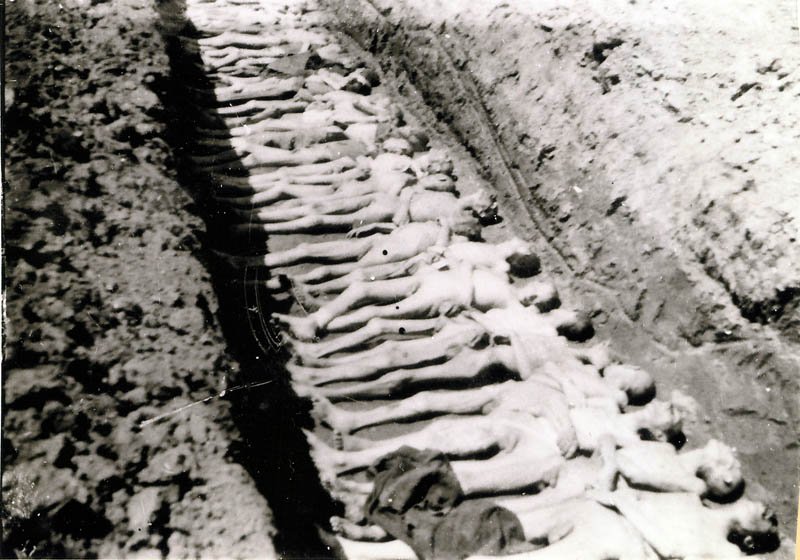 |
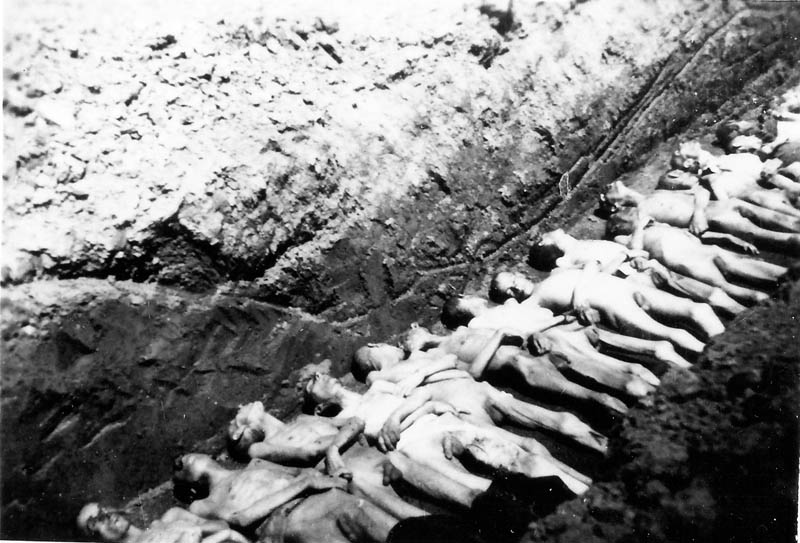 |
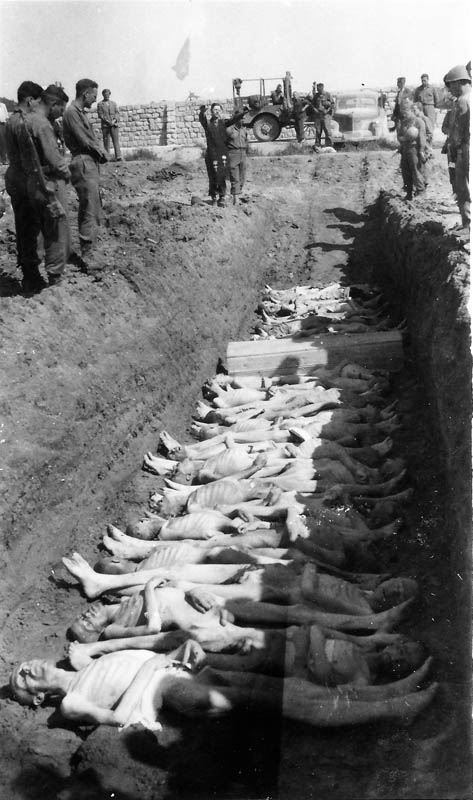 |
|
|
|

